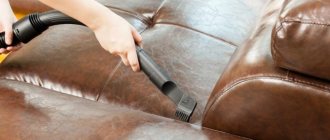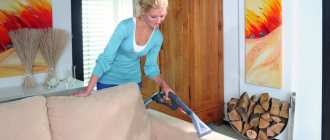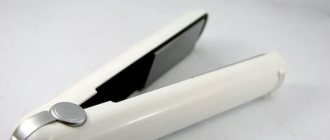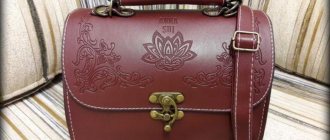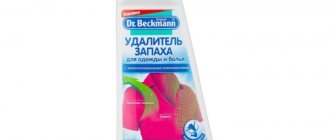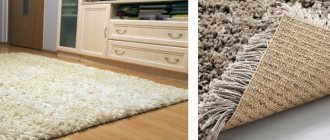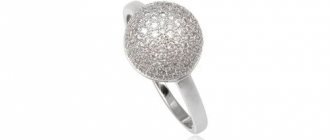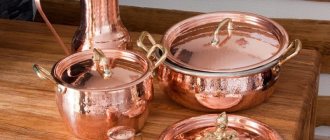09.25.2020 Clean house
You may or may not like polished furniture, everyone has their own taste. Now completely different materials and textures are in fashion, but, nevertheless, polished chests of drawers, wardrobes, tables and trellises stubbornly do not leave the interiors of modern houses and apartments. Some people value them as a memory of their beloved grandmother, some people feel sorry for throwing away good furniture, some people really like it and don’t want anything else.
In any case, if you already have an item with such a coating in your apartment, you need to know how to clean polished furniture at home and not spoil it even more. The polished finish is very sensitive and capricious; fingerprints and dust are instantly visible on it, and scratches appear easily. That’s why he also needs special care.
Rules for cleaning leather furniture
After wet cleaning, dry the leather sofa with a napkin
Despite the undoubted resistance of natural and artificial leather to dirt, non-compliance with technology when washing it can worsen the situation and even damage the coating. Therefore, such sofas must be cleaned following the following rules:
- Wipe any stains and marks in a circular motion without applying too much pressure.
- Be sure to thoroughly clean seams and folds where dust accumulates.
- Do not use any products containing abrasive particles or hard bristled brushes.
- When diluting detergent compositions, do not use tap water - only filtered water.
- Clean dirt exclusively with warm water and solutions, as hot dirt will be absorbed into the pores of the skin.
- Do not remove stains using aggressive detergents containing chlorine or technical liquids - acetone, turpentine, solvents.
- After wet wiping the sofa, dry the entire treated surface with napkins.
- Do not use a hair dryer when drying.
The work must be carried out in such a way that it does not spoil the skin. Even minor damage will begin to accumulate dirt, and it is very difficult to remove it from cracks and abrasions.
Safe cleaning tools
When processing polished furniture, it is easy not only to remove dirt, but also to damage the varnish layer. Therefore, it is unacceptable to use any harsh objects - scrapers, coarse bristles, abrasive sponges.
- cotton and flannel fabrics;
- suede cuts;
- cotton pads and tampons;
- pieces of soft leather;
- light brushes to sweep away dust.
To remove stuck-on dirt, you will need a table knife or a metal spatula.
It is advisable not to clean the surface of the furniture directly with sharp objects, but first slightly heat the metal over a fire or in boiling water. After this, the wax or paraffin will be easier to remove from the polish.
How to properly wet clean furniture
If dust has settled on the furniture or minor stains have appeared, we recommend using a single wet cleaning technology. It is suitable for all types of fabric, does not take much time and gives an effective result.
Necessary materials:
- kitchen sponge (foam);
- vacuum cleaner;
- carpet cleaner;
- carpet brush with bristles of the same length;
- container with warm water.
Technology
- Soak the sponge in warm water, squeeze it a little so that water does not flow from it in a stream. Treat contaminated areas.
- Prepare a cleaning solution: pour 1 capful of carpet cleaning liquid into 3.5 liters of water, stir until foam rises.
- Dampen the sponge in the prepared solution, wring it out and wipe the upholstered furniture.
- Take a carpet brush and scrub the stained areas. If you have faux leather furniture, don't press the brush too hard.
- Dip the sponge into clean water and remove any remaining foam. To avoid stains remaining after local treatment, distribute the soap solution evenly over the entire surface of the furniture. Scrub with a brush without applying much effort.
- Dip the sponge back into the bowl of clean water and remove the foam. Repeat the steps several times until you are sure that the cleaning solution has been completely removed.
- In cases where the surface of upholstered furniture is made of textiles, it must be vacuumed to prevent the formation of mold. Turn on the device at medium power, change the attachment to a soft brush, and go over the entire surface. If the room is dry, you can skip this step.
Proven folk methods
You can also clean polished furniture using folk remedies. After all, many people do not want to use household chemicals in their home. To make cleaning more effective, before starting cleaning, it is recommended to wipe the furniture with a solution consisting of fabric softener, mild shampoo and warm water in a ratio of 1:1:8. After preliminary cleansing, you can begin removing dirt:
- Mix vegetable oil and wine vinegar, apply the solution to polished wood, and after thirty minutes wipe with a dry, clean cloth.
- Regular milk removes dirt well. The facades should be wiped with a cloth soaked in milk, then the stains should be removed.
- Another effective remedy is sauerkraut brine. For rubbing, it is best to use a piece of genuine leather, which must be soaked in brine and all dirt must be removed with the leather. Blot the remaining brine with a soft cloth and polish the wood with warm furniture wax.
Cleaning is recommended to be done regularly, as old dirt will be difficult to remove.
After the basic procedures, you can begin to restore the original shine and gloss.
- Mix one part each of turpentine and vegetable oil, add one part table vinegar and treat the facades with the resulting solution. After fifteen minutes, polish the wood with a dry flannel cloth.
- Soak cotton pads in burdock oil, rub polished furniture with them, let them absorb and wipe dry with a cotton cloth.
- Boil 300 milliliters of beer, dissolve a small piece of natural wax in it and cool the mixture slightly. Rub it on all furniture surfaces. Advice: if the color of the furniture is dark, then it is better to take dark varieties of beer; for light wood, light beer is suitable.
- Make a mixture of kerosene and unrefined vegetable oil (5:1), apply to the facades, polish with a woolen cloth.
All these products create a protective layer that prevents further absorption of grease and dirt. It should be taken into account that if the furniture is subjected to heavy use, for example, in the kitchen, then the facades need to be cleaned every two or three days.
How and how to clean polished furniture
You need to take care of polished furniture in a timely manner, avoiding large accumulations of dirt and dust. During production, facades are coated with protective resins to prevent deformation of the canvas, and then polished. Due to long-term use, the top layer wears off and the set becomes dull.
You should only wipe furniture with a soft cloth so as not to damage the smooth surface. It is recommended to use napkins made of flannel, flannel, felt, ivy, and microfiber. It is strictly forbidden to scrub stains with a metal scraper or a hard dishwashing sponge.
We recommend
How to clean mouse pads made from different materials
Professional products
Modern manufacturers offer a wide range of professional polished furniture care products in the form of aerosols, creams and concentrates. The composition of the polishes includes:
- waxes that level the structure of the material;
- natural oils and silicone, which adds shine to the headset;
- solvents that remove stains from the surface;
- flavorings that give a pleasant smell;
- antistatic agents that prevent the attraction of dust to the surface.
Cleaning furniture using special household chemicals helps to increase its service life: a protective layer is formed on the facades, which prevents the penetration of moisture, protects from sunlight, masks scratches and increases the wear resistance of the material.
The most effective polishes include:
- "Pronto"
- "Chirton"
- "Emsal";
- "Lux"
- "Mebelux";
- "Cinderella";
- "Fairytale Furniture"
The last three items are from domestic manufacturers, and their effectiveness is no worse than that of their imported counterparts.
Traditional methods
The advantage of traditional methods is naturalness and hypoallergenicity. You should start by removing stains and minor dirt. To do this you need to mix 8 tbsp. l. water with shampoo and antistatic agent (1 tbsp each), moisten a flannel flap in the solution and wash the glossy surface with it. The resulting product has antistatic properties, so dust will not quickly settle on the facades. Embossed and carved elements can be carefully cleaned with a toothbrush.
After processing, you can begin polishing. This is a prerequisite for the formation of a protective layer; Moreover, after the procedure, the facades will again become shiny and glossy. Depending on the availability of certain ingredients, you can choose one of the proposed recipes:
- take 4 tablespoons of linseed oil and turpentine, add 2 tablespoons of vinegar, mix, pour into a spray bottle (the product is suitable for light-colored furniture);
- soak several cotton pads in burdock oil, squeeze out, put in a cotton sock;
- mix vegetable oil with kerosene in a ratio of 1:5;
- mix olive oil and wine vinegar in equal proportions;
- add a piece of paraffin or wax to 250 ml of beer, boil, cool.
Treat the facades with the resulting product, then polish with a piece of woolen cloth.
Furniture that is subject to the most use (for example, kitchen units) needs more frequent cleaning. It is advisable to carry out a similar procedure weekly and remove grease stains and fingerprints immediately after they appear. Otherwise, glossy facades will quickly become unusable.
How to clean polished furniture at home
Cleaning polished furniture is done using special products or available home remedies. The main point of care is dust removal.
Smooth surfaces are wiped with a dry flannel cloth; fragments with figured carvings can be cleaned with a vacuum cleaner or brush.
Main types of store compositions:
- products that remove dust and reduce electrification from furniture;
- Oil-based polishes add shine;
- In addition to cleaning, products with waxes form a protective film that protects against moisture and other unfavorable factors.
From fingerprints
Our skin contains many sebaceous ducts. Fingerprints on polished beautiful furniture most often have a fatty base. To clean horizontal table tops or chests of drawers, you need to sprinkle a thin layer of talcum powder on the stains. Then the surface must be wiped with a dry soft cloth. Vertical cabinet doors can be easily cleaned of fingerprints with half a cut raw potato.
From traces of hot dishes
Whitish circles from hot objects can be removed at home in several ways:
- You can apply Vaseline to the stain, leave it for 2-3 hours, and clean the problem area on a polished table or shelf with a flannel or a piece of suede.
- Mix table salt with vegetable oil and apply to the print. After 2-3 hours, remove the remaining mixture from the furniture and clean the treated area with a woolen cloth.
- The whitish mark is rubbed with a piece of paraffin candle, covered with a cotton cloth, and ironed with a warm iron.
The listed methods are effective if the impact of hot objects on the furniture was not critical and the varnish layer did not crack.
Instead of cleaning stains on a polished surface, it is better to prevent such marks from appearing by covering tables with tablecloths, napkins, or bamboo coasters.
Oily stains
Dining tables and kitchen cabinet fronts often get dirty. A fresh stain is covered with flour, then wiped with a cotton pad soaked in vegetable oil. Old fat is more difficult to clean off at home. Mix baking soda with any oil: olive, burdock, sunflower. Apply the paste to the contaminated area, then rub the cleaned area with a soft cloth.
A concentrated soap solution has good degreasing properties. To clean a polished furniture set, grate a piece of laundry soap, dissolve it in warm water, add a few drops of liquid dishwashing detergent. Dampen a cloth and clean problem areas. An alternative method is to lather a slightly damp cloth and wipe the oily areas.
Difficult spots
Sometimes stains appear on polished home furniture, the origin of which is unknown, but they are difficult to remove. One of the effective means for cleaning polished shiny furniture at home is kerosene. It cleans wonderfully and adds shine to the varnish coating. After using kerosene, the room must be thoroughly ventilated.
An ammonia aqueous solution can help clean severe stains at home: mix 10 ml of ammonia with 50 ml of water. Dampen the sponge and clean the stained areas.
An emulsion made from equal parts of vegetable oil and medical alcohol is another great assistant in the fight against complex stains. After cleaning, wipe the treated area first with a damp and then with a dry soft cloth.
Sticky tape marks on polished, beautiful furniture can be removed with undiluted dishwashing detergent, citrus essential oil, or a regular school eraser. The adhesive tape is rubbed off slowly, and you should not use extra force to avoid leaving scratches on the varnish. In difficult cases, try cleaning sticky marks with nail polish remover that does not contain acetone. First, test how the chemical works in an inconspicuous area. Traces of brilliant green, ink or children's markers can be easily cleaned with warmed beer.
How to wipe furniture to make it shine
Over time, the polished surface of furniture loses its glossy shine. This is due to direct sunlight and improper care of the varnish coating. Manufacturers of household chemicals produce products that restore the mirror shine of polished home fittings. The composition includes various waxes and antistatic agents.
Furniture will shine if you clean it with a homemade polish. The basis of such a preparation is any vegetable oil. Turpentine is added to it in a ratio of 1:1 or kerosene, for 1 part oil - 5 parts kerosene.
Mix 1 tbsp. l. any shampoo and liquid antistatic agent, pour 8 tbsp into the resulting mixture. l. water. The resulting solution will thoroughly clean polished surfaces from dirt and prevent dust from quickly settling on bedside tables and cabinets.
Do not clean the varnished surface at home with aggressive substances: alcohol, acetone, acids, alkalis. Avoid abrasive powder products. Caring for polished, shiny furniture should be gentle. Compliance with all the rules will provide lacquered interior items with a luxurious appearance and extend their service life.
How to properly care for polished furniture
First of all, it is worth noting that it is strongly not recommended to use pure alcohol and acetone when cleaning. They must be diluted with water.
Contaminants can be easily cleaned using the standard method - soapy water. It is applied with a soft cloth. And then, to add shine, the surface is wiped with natural wool material.
Water stains can also be easily removed with a soap solution. The main thing is to always wipe the surface dry after treating with the solution. Finger stains can be removed by rubbing them with talcum powder or cut fresh potatoes.
More serious stains can be removed using other recipes. Old stains are removed using vegetable oil. Then it is removed with a damp cloth, and to add shine, the surface is wiped with a soft cloth.
How to clean polished furniture from grease stains using flour? Such contaminants are first sprinkled with it, and then lubricated with vegetable oil. Ethyl alcohol can also be mixed with oil in equal proportions. This solution breaks down fat well, which is then removed with a flannel cloth.
To remove marks from hot surfaces, such as an iron, you need to use regular table salt. It is placed in a soft cloth, blotted in sunflower oil and the problem area is wiped with the resulting instrument.
How to clean polished furniture from old stains? Use vinegar. It should be slightly warmed up, then a cotton swab is soaked in it, and the resulting solution is applied to the problematic stain. After treatment, wipe the surface dry, and then apply colorless shoe polish to polish it.
When leaving, you should adhere to a certain list of rules.
Polishing agents
It is necessary to renew the smooth layer on the surface of the furniture regularly, and after exposure to any cleaning agents, it is imperative.
For this purpose, in addition to industrially produced polishes, you can also use homemade compositions from household substances:
- Burr oil . Plant extract is best suited for polishing furniture without adding additional components. Using a cotton swab soaked in the composition, wipe the entire surface with little effort.
- Vegetable oil with vinegar . This mixture is prepared by mixing the components in equal volumetric proportions. Then apply to polish and rub.
- Beer . A piece of wax or paraffin is added to the beer being heated for cleaning. After cooling, a composition is obtained that can clean off dirt and simultaneously polish the same area.
In more advanced cases, a complex restorative mixture will help. It is prepared by mixing turpentine, linseed oil and vinegar in a volume ratio of 2:2:1. Before use, shake the composition vigorously and apply the resulting emulsion to the area with the damaged varnish layer.
All polishing agents are rubbed in a circular motion. It is not recommended to use sponges and brushes. The best tool is flannel or suede.
Caring for polished furniture. TOP 15 methods on how to clean polished furniture at home
Polished furniture requires careful care. Therefore, such items are rarely found in the home. Polished surfaces “attract” various types of dirt and are “afraid” of scratches. This means that there are only a limited number of products suitable for cleaning such items. But, despite such features, there are several solutions to the question of how to clean polished furniture yourself.
Main problems with lacquered furniture
Such home furnishings acquire their characteristic shine due to the fact that during the production process the wood is coated with special compounds containing resins and varnishes.
Due to these features, furniture:
- quickly absorbs various contaminants;
- prone to the formation of microcracks and chips;
- accumulates static electricity, which attracts dust.
Polished furniture has strict maintenance requirements. Such items should not be placed in rooms with high humidity levels or in places exposed to direct sunlight.
Lacquered surfaces do not tolerate temperature changes and exposure to abrasive particles. In both cases, cracks appear.
After cleaning the varnished surface with a damp cloth, stains remain, and the dry material electrifies the material, thereby facilitating the settling of dust.
What might you need?
You can clean varnished surfaces using:
- soft cloth;
- cotton swabs;
- leather (it is recommended to take soft and thin skin);
- a brush with soft bristles.
To clean polished home furnishings, you will need not only cleaning products, but also a knife to remove serious stains.
Soft flannel or cotton cloth
Flannel and cotton fabric practically do not electrify varnished wood and do not leave streaks. Therefore, it is often recommended to wipe furniture with this material.
Cleaning methods at home
To remove stains from a varnished surface, household chemicals and folk remedies are used. The latter often allow you to achieve a more pronounced effect.
Beer
To remove traces of dirt, you will need to mix malt beer and wax. This composition must be boiled to remove the alcohol.
Then you can rub the furniture with the resulting solution. Beer can remove various types of dirt, and wax will return the varnished surface to its original color.
Special solution
A mixture of shampoo, water and antistatic agent, taken in equal proportions, helps to remove stubborn dirt and grease from polished furniture with your own hands. The latter prevents dust from settling on the surface.
Olive oil and wine vinegar
To clean furniture, you need to mix both components in equal proportions and wash the varnished surface. Wine vinegar can cope with various types of stains. At the same time, the liquid disinfects the surface being treated. Olive oil is used to restore shine.
Burr oil
To remove dirty stains, just apply this oil to problem areas and after 5-7 minutes wipe the surface with a dry material.
Varieties
Of the many different polishes produced at home, several stand out as effective and easy to prepare. The ingredients that make up them are found in every home. Polishes are most effective immediately after preparation, so mix the ingredients before use. Such polishes include compositions based on ammonia, vinegar, olive oil and lemon, as well as wax.
Also, home-made furniture polish is prepared using other simple ingredients, which include Vaseline. Denatured alcohol, turpentine, shellac and lanolin are also suitable for preparing a polishing composition. It is worth noting that they will be less environmentally friendly, which is a disadvantage. The components included in such polishes are difficult to purchase, which makes the preparation process more complicated. When choosing a substance as the main component of the polishing mixture, you need to know exactly what surfaces it is intended for.
With ammonia
A product based on ammonia is suitable for kitchen countertops, bar counters, and painted surfaces. It will protect furniture from dust and remove existing dirt. This composition does not leave cloudy stains after application, which allows you to achieve a mirror shine on glossy surfaces, glass and metal fittings.
The advantage of this composition is its ease of manufacture and availability. To prepare it you will not need anything other than ammonia and water. The product can be stored for a long time, it does not deteriorate and does not lose its original qualities. Among the main disadvantages of such a polish, one can name only an unpleasant odor, but the fact that ammonia contains much less water makes it almost imperceptible. Moreover, the smell of ammonia disappears very quickly.
With vinegar
For lacquered furniture, vinegar-based formulations would be an ideal option. They will return the furniture to its original appearance, degrease its surface, and remove sticky deposits. In addition, vinegar neutralizes alkaline substances such as limescale. Thanks to the use of this product, you can easily deal with marks from mugs and glasses on a wooden table or other surface.
For a standard preparation recipe, you need to use 70% essence as a polishing component. If it is replaced with 9% vinegar, then its amount must be increased accordingly. This composition is stored in a glass or ceramic container. In this case, the period of its use is practically unlimited.
To make polish with vinegar have a pleasant smell, you can add a couple of drops of any essential oil to it. The choice of this component depends only on the preferences of the person who will clean the house.
With olive oil and lemon
The product prepared using olive oil must be used immediately; storing it is not recommended. It is strictly forbidden to use olive oil-based polish on varnished surfaces. This is explained by the fact that the top layer of varnish will not allow the oil to be absorbed; it completely remains on the surface, making it greasy. In addition, using this composition on antique furniture that has a delicate finish may cause a “haze” to appear on it. In order to find out how the surface will behave after exposure to the composition, first use it on a small area in an inconspicuous place.
If it was not possible to polish the surface to the required condition the first time, then after a short period of time you can reapply the composition and perform all the steps again. In this case, the first portion of the product will have time to be absorbed into the wooden surface, and the second will give it shine.
Wax based
Wax-based polishing compounds are designed not only to prevent dust from settling and to add shine to the surface, but also to mask small defects: shallow scratches and chips. Wax fills them in, making them less noticeable. The use of such a product ensures that there is no need for frequent application - the wax film does not wear off from the treated area for a long time. The disadvantage of this composition is the appearance of fingerprints visible to the eye after any touch.
Essential oils are often added to wax-based polishes. This is done because they disinfect the surface being treated. For these purposes, certain types of essential oils are used: lavender, eucalyptus, oregano, juniper, clove, tea tree, cintronella and thyme. In addition, tea tree oil helps get rid of mold.
Other types
Compositions with denatured alcohol, turpentine and shellac are less safe for humans compared to the above. Their use is comparable to the use of conventional store-bought polishes. Such compositions are used when all the necessary ingredients are in the house, but it is not possible to buy a regular polish. But despite this, it is these components that have enhanced cleaning properties, and if compositions with vinegar, ammonia or wax fail to deal with dirt and polish furniture, then a small amount of denatured alcohol is added to them. After this, removing dirt from the surface is very quick and easy. In addition, such compositions provide good surface disinfection and help remove fungus and mold, which in some cases is simply necessary. A good example of such an application is cleaning the bathroom, where there may also be wooden furniture.
How to clean wooden furniture. HOW to easily clean KITCHEN FURNITURE from greasy deposits
Grease stains on kitchen surfaces are normal. During cooking, they can end up in the most unexpected places. Sometimes you even have to wash the ceiling.
But you can’t use the first product that catches your eye.
It is important to consider what material the surfaces are made from so as not to harm their appearance.
Cleaning your kitchen of grease is very easy if you do it right.
As a rule, the parts closest to the cooking area suffer the most from fat. And this role is always occupied by kitchen furniture. It is made from several popular materials, each of which has its own characteristics. It is worth considering kitchens made of MDF, wood and plastic.
How to work with MDF
MDF kitchens are distinguished by the beautiful and durable material from which the surfaces are made. They require a thorough approach to cleaning, as they can be easily damaged. There are three ways to wash them from fat.
Mustard
A specially hand-prepared paste will allow you to wash away old grease from your favorite kitchen furniture. This method can also be used for household appliances and stone coatings.
How to achieve the result:
Mix some mustard powder with water to form a thick mass. Apply it to all problem areas for a few minutes.
Carefully remove any residue with a soft cloth soaked in warm water.
All the fat will remain on the rag. Therefore, you should only take fabric that can be thrown away.
Ammonia
A popular means of getting rid of contaminants since ancient times is ammonia. It can have a negative effect on some materials, but in this case it is harmless.
What to do:
- Dilute a liter of water with a spoon of ammonia.
- Fill a spray bottle with them.
- Spray onto all stained areas.
- Blot with a dry cloth.
This method cannot be used to clean a glossy kitchen, as this may cause unsightly liquid marks to form.
Alcohol, vinegar, lemon
An ideal option for modular kitchens with glossy finishes, which will suit the white color. It will not harm even low-quality materials, making it an almost universal means of removing dirt on kitchen cabinets and other surfaces.
How to proceed:
- Mix equal parts of vinegar, alcohol and lemon juice or grated zest.
- Blot with a soft cloth and wash off all dirty marks.
- Wipe with a clean cloth.
How and with what to clean a wooden kitchen
Cleaning a kitchen made of wood is no more difficult than any other. You just need to use certain tools that are suitable specifically for it.
Oil, soda
The combination of vegetable oil and baking soda does an excellent job of removing various stains, ridding the kitchen of plaque or other contaminants.
How to wash:
Mix the oil in a ratio of 1 to 2, distribute, treat with a sponge without hard lint and then rinse.
If cleaning a wooden kitchen with such actions does not work the first time, you can repeat it. Also, instead of this mixture, you can use lemon slices, which you need to wipe all the necessary places and wait ten minutes before rinsing.
Baking powder for the dough
Baking powder, known to all chefs, instantly cleans countertops and other furniture. You will need a volume of powder that is enough to cover all dirty spots.
Application:
Dilute the powder slightly with water to obtain a thick paste.
How to cook
It is easiest to make furniture polish at home using ammonia. To do this you will need:
- 2 teaspoons of ammonia;
- 1 liter of warm water.
All ingredients are thoroughly mixed, the solution is poured into a container with a spray bottle. They are used to treat surfaces to be cleaned, wiping off excess composition with a lint-free cloth.
An easy-to-make homemade polish is a vinegar-based polish. When creating it, use:
- 1 liter of warm water;
- 2 teaspoons of vinegar essence.
This product must be used using a spray bottle and a cloth.
A solution of olive oil and lemon is prepared without adding water. For this use:
- 1 glass of olive oil;
- 1/4 cup lemon juice.
All ingredients are thoroughly mixed before applying to the surface. The product must be shaken well before each use.
Recommendation: it is better to prepare a composition with olive oil using mineral oil, sold in a pharmacy. This will be more economical and safer, since they monitor the expiration dates of goods more carefully and the oil will not be spoiled.
When answering the question of how to make polish from wax, which is a fairly solid substance, you need to remember that it melts under high temperature. To create a homemade wax polish, you need:
- 2 tablespoons of wax;
- 1 glass of olive oil;
- 0.5 teaspoon of any essential oil.
The wax is heated in a water bath. Then olive and essential oil are added to the resulting mass. Wait until the mixture has cooled completely and polish the surface by rubbing it with a cotton cloth. A polish containing petroleum jelly is prepared in the same way as a wax product. When preparing it you will need:
- 3/4 cup Vaseline;
- 1/4 cup wax;
- 1 teaspoon essential oil.
The wax is heated in a water bath, Vaseline and essential oil are added. Once the mixture has cooled, you can polish the surface of wooden furniture using a cotton cloth.
A composition based on denatured alcohol is prepared by thoroughly mixing all the ingredients in exact quantities, which include:
- 3 tablespoons of denatured alcohol;
- 3 tablespoons shellac.
When making a mixture of turpentine, lanolin, soybean oil and beeswax, all ingredients are mixed in a ratio of 2:2:8:1. Beeswax is melted first in a water bath, and the remaining ingredients are added to it.
Recommendation: To use a polish containing olive oil or wax, use only a lint-free cloth. If you ignore this rule, particles of matter will lag behind on the surface.
By choosing a polish prepared at home instead of a store-bought one, you can not only ensure safe cleaning and protection of wooden furniture, but also know for sure that the surface will not deteriorate during the cleaning process. The composition indicated on the label is not always complete and reliable, which means it is impossible to predict the exact result.
Types of facades and cleaning methods
Kitchen surfaces come in a variety of materials. They react differently to cleaning powders and concentrates. Before cleaning, you need to know everything about the features and methods of cleaning furniture facades.
MDF
Furniture is formed from slabs, which are created by mixing a fine fraction of wood waste and glue. Alcohol-based products should be used when caring for the headset. Do not clean surfaces coated with a special film, toothpastes, baking soda, or salt due to the increased abrasiveness of the substances. Using a steam cleaner can damage furniture, as the film will peel off over time.
Wood
It is better to wipe natural wood cabinets with folk remedies. Use mustard powder, baking soda, salt, and lemon juice to wash the headset. If the furniture is polished, then you can return it to its original appearance by wiping it with a slice of raw potato.
A steam cleaner for wood must be used carefully to prevent the material from peeling off. It is better to wipe a wooden table with a dry flannel cloth or sponge.
Chipboard
Grease stains on particleboard furniture are wiped off with a damp cloth or napkin soaked in vinegar, alcohol, or acetone. Use a melamine sponge and a solution of laundry soap for cleaning. Stains from hot coffee, chocolate, and wine are removed faster by scrubbing with vodka and sunflower oil.
Laminated chipboard
Tabletops and cabinet furniture are made from laminated chipboard. The glossy surface looks high quality and is easy to care for. Non-aggressive products can be used for cleaning. The set should be washed with a soft cloth or sponge without hard brushes.
Plastic
Plastic kitchen furniture fronts are resistant to abrasive powders, but they should be used carefully. Otherwise, the surface will wear away faster. Do not use products containing chlorine on plastic. Do not use polishes with wax. Sticky surfaces will attract dust, dirt, and grease.
Glass
The fragile material is susceptible to mechanical damage. It is better to wipe glass shelves with a sponge dipped in soapy water. Finally, rinse with clean water and polish with a dry cloth. Alcohol-based window cleaners are also used for cleaning.
Some more useful tips
If there are traces of wax on the furniture, they can be cleaned without damaging the surface of the furniture. To do this, you need to heat the knife in boiling water and use the blunt side to clean off the dried wax. Next, use a gasoline rag to wipe the area where the wax mark was.
If, for example, you stained a table with ink, then cleaning such stains at home will be as easy as shelling pears. To do this, you need to take heated beer and pour it over the stain, wait until everything dries, spread wax on the stain and polish.
In order to keep your furniture clean, you should follow a few simple rules.
- Regular care of furniture is a guarantee of its cleanliness and beauty.
- Avoiding household chemicals when caring for furniture at home will help avoid allergies.
- The use of soft fabrics and sponges when caring for furniture will help prevent scratches and damage.
- A soft brush will help to thoroughly clean furniture that has threads.
- Avoid alcohol, cologne and acetone when cleaning furniture, as they dull the surface.
If, over time, polished furniture has faded or changed color, you must adhere to the following tips:
- wipe off dust, clean the furniture surface with warm water and wipe with a dry soft cloth;
- the next step is to prepare a special solution consisting of linseed oil and turpentine, as well as table vinegar;
- mix all the components, moisten a cotton swab in the resulting solution and treat the furniture surface with it;
- Furniture should be cleaned quickly enough so that its surface does not heat up. In this case, the oil reacts with other components, oxidizes and returns the furniture to its former shine and beauty.
By following these simple recommendations, you can keep all the furniture in your home in perfect order and it will look like new. And this costs a lot, because it would be simply unreasonable to buy new furniture due to the formation of stains on the old one, which can be easily dealt with.
Also see
- Anti-aging haircuts for women after 35, 40, 50 and 60 years old
February 29
- Fashionable short bob haircut in 2021
January 14
- Fashionable haircuts 2021: bobs for blondes and brunettes
January 9
- Stylish haircuts for short hair 2020
December 18
- Types and varieties of bob haircuts
February 6
- Fashion trends,Haircuts
Women's haircuts 2021: fashionable cascade
June 20
- Stepped women's haircuts ladder and cascade in 2021
September 3
- Fashionable knitted sweaters 2020
6 September
- Fashionable evening dresses - 2020
February 17
- Do-it-yourself table setting: description and photo
28 January
- Setting the table with paper napkins
28th of February
- Asymmetrical oblique haircuts 2020
November 12
Reasons for contamination of polished objects
Due to careless handling, stains appear on polished furniture
As with any furniture, the main reason is dust settling on smooth tables, cabinets and bedside tables. But varnished surfaces not treated with antistatic agents have an increased ability to “attract” the smallest particles. Microcracks in the smooth layer also accumulate contaminants, which are difficult to remove. Therefore, the fight against dust on polished furniture is especially important.
Additional causes of pollution are:
- greasy fingerprints left after touching the polish;
- stains from any spilled liquid;
- stains from wet wiping of furniture that were not removed in time by additional polishing;
- stuck pieces of paraffin, wax or plasticine;
- traces from the impact of hot objects placed on the surface without gaskets.
In addition to dust, most pollution is created by one’s own hands as a result of negligence when handling furniture. You can avoid them by following simple rules. But we cannot rule out chance.
If stains do appear on polished furniture, you need to be able to remove them correctly without causing additional harm.
Principles of cleansing at home
Tips for caring for stainless steel are very simple. They are easy to follow.
What not to use
List of products and devices that should not be used when using stainless steel cookware:
- Dishwasher;
- metal sponge;
- a cleaner containing abrasive components.
How to use baking soda and salt
Salt and soda are essential care products for stainless steel cookware. The principle of their use is simple:
- the product is washed;
- apply soda, salt or a mixture thereof to the contaminated area;
- rub the powder in a circular motion.
After cleaning, the item is rinsed with water and dried with a towel.
Timeliness
Regular cleaning of stainless steel pans eliminates the appearance of old stains. It takes little time to remove fresh stains.
To avoid divorces
After each wash, wipe the dishes dry with a kitchen towel. There are no streaks on a clean, dry surface.
How to remove stains from chipboard or MDF furniture
- Fresh grease stains can be removed simply with water and non-aggressive soap, and then quickly blotted with a paper napkin.
- coffee stains with ethyl alcohol or ammonia solution.
- Acid stains are removed using a solution of vinegar or lemon essence.
- stains of juice, wine, chocolate with a neutral detergent, blot a napkin with it and apply it to the stain for a couple of minutes, and then dry the area with another dry napkin.
- Removing white stains from wax or chewing gum from furniture is not difficult. Dry the area and remove any dirt with a scraper.
- Stains from manicures, smoking, cosmetics or children's drawings can be removed with a sponge and a solvent such as acetone.
- stubborn stains of paint or shoe polish using special products that are sold in building materials stores.
- In addition, the stain can be covered with a special camouflage pencil for laminate flooring. You can buy it in building materials, the main thing is to choose the right color and tone that matches the damaged furniture.
The best stain prevention is regular furniture care . After all, special furniture care products not only prolong its life, but also protect against deep penetration of stains by creating a protective layer.
What home methods for dealing with stains on wooden, glass, and polished furniture do you know? We will be grateful for your advice!
Features of caring for polished furniture
To give wooden furniture a glossy look, first of all, its facade is thoroughly cleaned, then it is coated with protective resins and varnish, and finally, it is polished in a special way. As a result of this treatment, the surface becomes like a mirror surface. Thanks to this, the products have an expressive and elegant look.
https://youtube.com/watch?v=kQDwygqqhKg
But furniture with varnish coating has a number of disadvantages in operation:
- ability to strongly attract dust;
- ability to quickly absorb dirt;
- increased sensitivity to mechanical damage, which often leads to the appearance of cracks and cracks.
In order to avoid such troubles, you must have special knowledge on caring for such furniture. Polished furniture, like any other, is greatly damaged by excessive dryness, dampness, exposure to direct sunlight, dust, and installation near radiators. The influence of each of these factors leads to the fact that the furniture begins to age and fade, and the varnish surface may become covered with stains and cracks.
Failure to comply with precautions may result in deformation
The peculiarity of caring for polished furniture is that it has to be wiped every day with a piece of soft flannel or plush fabric. This is due to the fact that dust is very visible on its surface. In production there are fluffy napkins impregnated with a special substance that not only remove dust, but also make the surface of the furniture shiny.
There are many different preparations for caring for polished furniture. A popular product is “Polish”. Apply the product to a flannel cloth to wipe the furniture and leave for 20-30 minutes, then rub until shiny. For polishing, polish or polishing paste is suitable, which must be applied to the surface and rubbed in a circular motion using a piece of woolen material. After some time, the surface must be wiped with a piece of soft cloth.
Safe chemicals and improvised means
The varnish coating is sensitive to abrasive cleaning agents, chemical solvents and mechanical stress. It is unacceptable to clean the polished wall or cabinet doors with a wire brush, acetone or gasoline. With such care, furniture polish will, at best, become dull, and at worst, it will crack, crumble and crumble.
Today, hardware stores offer a wide selection of specialized products for the care of polished furniture. The use of each of them gives a certain effect, which must be taken into account.
Here are some of the most popular products used to care for furniture with varnished surfaces:
- Wax-based polishes - Joy By Joy, Pronto, Chirton, Emsal.
- Compositions with a tinting effect - Pronto, 5+, Emsal.
- Products that create a protective layer are Diva, Mebelux, Luxus.
- Based on silicone - “Cinderella”, “Anti-dust”.
These tools are very easy to use. It is enough to apply a small amount of the composition on a dry cloth and polish the varnish surface to a shine.
Before starting cleaning, you need to test the product by treating a small area of the surface in an inconspicuous place.
To avoid damaging the varnish layer when removing stains, do not use hard metal brushes or scrapers. It is better to use cotton or flannel napkins, cotton pads, and soft brushes to remove dust. Sticky wax or plasticine can be removed with a wooden stick or spatula.
Features of caring for polished home furniture
To ensure that the need to clean varnished furniture arises as rarely as possible, it must be properly cared for. Here are some basic recommendations that will help you keep your wardrobes, bedside tables and cabinets in perfect condition:
- Lacquered furniture must be cleaned of dust deposits daily. This should be done with a dry soft cloth.
- Under no circumstances should you install a furniture set in a room that is located on the sunny side, or in a room with high humidity. The fact is that external environmental factors can lead to deformation of polished furniture.
- Do not place dishes with cold or hot contents on a shiny, flat surface. This may lead to cracking of the coating or the appearance of whitish spots.
- It is better to install polished furniture in the kitchen away from the stove. This will protect it from fat flying in all directions during cooking, because it is very difficult to wash off. In general, to avoid such problems, it is best to buy unpolished kitchen furniture made from MDF.
- You should handle the smooth surface as carefully as possible, since polishing quickly becomes covered with micro-scratches and gets dirty.
Removing stains
How to clean stains that appear on a surface coated with polish?
The following traditional methods are suitable for this:
- Adhered dirt is removed with soap. Lather a soft damp cloth and quickly wipe the contaminated surface. After this, the polishing should be wiped well with a clean felt rag.
- To clean the surface of old fingerprints, you can use raw potatoes. To do this, the potatoes are cut in half, and hand marks are processed with the cut. Then the treatment area is thoroughly rubbed with a dry cloth.
- In difficult cases, any vegetable oil will help. Soak a cotton swab in it so that the oil does not flow or drip, and wipe the stains until they are completely removed. Then the remaining fat is blotted with a paper towel, and the surface is polished with a dry cloth.
- How to remove stains left by hot objects? Fine salt is tied into a knot of thin cloth and dipped in vegetable oil. Rubbing whitish hot spots with such a knot restores the appearance of the polish.
Polishing is resistant to alcohol and solvents. Therefore, you cannot not only treat the surface with these products, but also spill them on the polish.
Cleaning different fabrics
Depending on what materials the chair or sofa is made of, their care differs. Furniture should be cleaned in accordance with the recommendations of specialists. The easiest way to care for synthetic fabrics is more difficult for natural ones.
Satin
Rice. 11 – Satin sofa upholstery
Cleaning this delicate material prohibits the use of a vacuum cleaner without a special rubber nozzle, the use of fluffy cloths, powders, bleaches and solvents. Microfiber, a clothes roller, soap solution and an iron are suitable for cleaning. You need to wash off the remaining products you use with plain water and dry them well so that the upholstery does not suffer from stains.
Plush
Furniture made from this material should be cleaned with a vacuum cleaner with an attachment. Preventative cleaning of plush coverings is carried out by knocking out or using a rag with a soap solution. Wring out the fabric thoroughly before use.
Flock
Heavily dirty furniture upholstered with this delicate fabric should not be treated with products based on solvents, alcohol, or gasoline. For flock upholstery, it is better to use substances with a water-based composition. Simple stains are removed with a damp sponge, old stains are removed by pre-soaking. Furniture should be vacuumed regularly. It is prohibited to wash the cover in the machine.
Velours
Such furniture can be easily cleaned from heavy dust with a clothes roller. Wet cleaning of velvet upholstery and velor coverings is carried out in the direction of the pile. Velor furniture should be dried naturally. To remove stains, use a soap-vinegar solution, flour, and aspirin solution.
Rice. 12 — Sofa with velor upholstery
Natural and artificial leather
Coating them requires a special approach. Dust and crumbs get clogged into micropores and deprive the product of its shine. Dirt is removed with a vacuum cleaner, then polished with Vaseline or oil - they are rubbed into the damp upholstery. Stains can only be removed using gentle methods.
From the tapestry
Fabric upholstery made from this material must be handled carefully - it does not tolerate high humidity, so you should not get the furniture too wet. Use well-wrung out rags. To remove stains, you can use vinegar or soap solutions, semolina for light-colored sofas, and brewing black tea for dark ones.
Suede
They clean it with special sprays, which should be sprayed in a well-ventilated area. For better protection of suede furniture (chairs, armchairs, etc.) - artificial or natural - apply 2-3 layers of the product and leave for 12 hours. Vacuum the material every week and wipe with a terry towel or microfiber. Remove stains with white vinegar and alcohol solution.
Silk
Furniture with such a coating must not be treated with household products, bleaches, or dried in the sun or near heat appliances. Alcohol can damage silk upholstery. For cleaning, it is advisable to choose dry methods or take the furniture to dry cleaning. The covers can be washed independently in a special mode without spinning.
Rice. 13 – Silk sofa
Gozhka
A very durable type of upholstery - durable and easy to care for. Sofas and chairs made of matting are quite easy to clean. Fabric coverings should be vacuumed with a soft attachment wrapped in gauze soaked in salt water. Once a year, you can wash the cover by hand in soapy water. Clean the lint in its direction daily. Remove fruit stains with soap, lipstick stains with alcohol, chocolate stains with ammonia.
Veneer
This coating must be wiped with a damp soft cloth and professionally used products that will not allow dust to settle on it. The use of scrapers and hard sponges on veneer furniture is prohibited. If the sofa is varnished with a wooden base, polish it with wax-based substances.
Cotton
Cotton furniture is cleaned with a damp cloth and vacuumed once a week with a soft nozzle. A soap solution will help get rid of stains of a wide variety of nature (although not all). Water-based products are also allowed.
Applying varnish
Let's talk about which varnishes are best to use. The best are considered alkyd (Tikkurila Unika-super series), polyurethane and water-polymer (good ones are Swedish Bask).
Despite the lack of odor, water-based varnish is not the best choice for your first varnishing experience. Essentially it is a water-based suspension. But it is far from being as harmless as is commonly believed. Water-based varnishes contain very harmful solvents, albeit in small quantities. It’s just that the usual acetone and others cannot keep such a composition in a stable state. So we have to use much “cooler” solvents.
This is by the way, but the reason is essentially different - difficulties during processing. When applying varnish, water is absorbed into the wood fibers and they rise. As a result, after the first treatment, the surface is far from smooth, but very rough. This effect is especially pronounced on pine products. So after the first layer of water-based varnish has dried, take an angle grinder or a sander, attach 320-grit sandpaper to it and sand it until smooth. If you're lucky, the next layer will lie flat and the pile won't rise again; if not, you'll have to repeat the operation again. The situation is not fatal, of course, but unpleasant. This does not happen with other varnishes.
How to apply varnish
Now a little about how to apply varnish. Professionals believe that the best method is spraying from a spray gun. This may be true, but not all home craftsmen have such a device, and you also need to be able to work with a spray gun. Among manual application methods, a popular method is application with a piece of foam rubber (or a new kitchen sponge) or a fabric swab (soft, white, lint-free fabric). To decide, you need to try what is more convenient for you, how it turns out smoother (if it works out at all).
The next method is with a small foam roller. Suitable if you are varnishing a surface of a simple shape without small details (a door leaf, for example).
Applying varnish with a brush is the most unpopular method
The use of brushes when varnishing furniture, oddly enough, is in last place. The fact is that it is difficult to evenly apply a layer of varnish in this way. You need a good brush with soft, thick, natural bristles, which should not tangle under any circumstances.
Technology
Regardless of the chosen method of applying varnish, its layers should be thin and of uniform thickness. Take a little product onto a brush/sponge/roller/tampon and rub it over the surface as thoroughly as possible. Next time we dip it in varnish only after the “weapon” no longer leaves any traces. In this way we cover the entire surface and leave to dry.
Many coats of varnish may be required
The applied layer of varnish does not dry completely, but the time indicated on the packaging of the varnish in the column “tack-free” or “application of the next layer”. On average, for water-based varnishes it is 1 hour, for alkyd varnishes - 5 hours. The next layer is applied using the same technique. The total number of layers is usually from 5 to 9, depending on the quality of the veneer and preliminary sanding. When the surface becomes absolutely smooth, the varnish is dried until completely dry - 2-3 days. After this, sanding begins again.
Polishing furniture: choosing the right folk remedy
Often, homemade polish is made with a fatty base (olive oil, petroleum jelly, turpentine or wax) or with the addition of vinegar, lemon and ammonia. It is recommended to mix the main ingredients immediately before use. Only in this case will they be effective. To understand how to polish furniture in a particular case, it is important to know some of the features of these substances.
To prepare polishing mixtures, use only glass or ceramic dishes.
Scraps of cotton or flannel fabric are used as cleaning accessories. The ideal option for this procedure is suede, soft leather and cotton pads.
"Fragrant" ammonia
A mixture of ammonia and water is suitable for cleaning kitchen units or bar counters. The suspension does not leave streaks on glass surfaces, as well as fittings made of metal.
To prepare such a solution, you will need:
- heat 1 liter of water;
- add 2 tsp. ammonia;
- stir the suspension thoroughly;
- pour it into a spray bottle;
- After applying the mixture to the countertop, rub the stains with a cloth (preferably lint-free).
This composition is perfect for all painted and varnished items. Moreover, it is stored for several years.
"Powerful" vinegar essence
Vinegar-based compositions (70%) are used to degrease objects and also clean them. Since an acidic environment neutralizes alkaline compounds, it is used to remove limescale that remains on tables after mugs. To obtain such a disinfectant for polishing furniture, you need to dilute 2 tsp. essences in a liter of warm water.
Many people don't like the pungent smell of vinegar. For this reason, a few drops of essential oil are added to it. It is worth knowing that tea tree ether is used to kill mold.
Original tandem - lemon and vegetable oil
Lemon juice and olive oil cannot be used for polishing furniture varnish, since the top layer of the surface will not be able to completely absorb the greasy emulsion. In addition, after it, antiques with fine finishes are often covered with a “haze.”
All other products can be treated with a simple product made from:
- 250 ml of any vegetable oil;
- ¼ cup lemon juice;
- The liquid is stirred until it becomes homogeneous.
Before polishing wood with oil, you need to check how it “reacts” to the resulting mixture. As an experiment, the composition is applied to a small area of the table and left for some time. If nothing happens, then cover all parts of the trellis with polish.
Lemon juice can be replaced with wine vinegar. It is also an excellent cleaner and disinfectant. Dilute oil and wine in equal parts. The mixture is applied in an even layer to the object, and then rubbed with a soft cloth.
Wax and its “competitors”
Furniture polishing paste with wax removes all cracks and chips. Essential oils of tea tree, eucalyptus, lavender or juniper are added to the mixture as a disinfectant ingredient. The resulting composition is applied to objects, wait until they dry and only then polish them.
There is another simple way to make furniture shiny:
- pour 1 glass of beer into the pan;
- wax/paraffin is immersed in liquid;
- bring the mass to a boil;
- leave it for a while to cool down.
You should not touch cabinets polished in this way, because all fingerprints will appear on them. Among other things, some housewives rub the set with regular talcum powder or baby powder, others use denatured alcohol, shellac or turpentine.
Sometimes folk remedies for polishing furniture do not help the first time, since the mixture is completely absorbed into the surface. For this reason, after a few hours or days, the composition is applied again.
In addition, you need to know what else to polish furniture with if you don’t have polish. Many people liked the tea leaves. It not only cleans the products, but also gives the wood a richer and deeper shade, refreshing it. To do this, you will need to squeeze out the tea leaves thoroughly, transfer the mixture into a piece of thick material and roll it into a bag. Use the resulting ball to wipe the entire set, and then polish it until shiny with flannel.
Fighting scratches
The appearance of scratches and chips on polished furniture usually baffles the owners of this piece of furniture. If you can’t deal with serious and large chips without the participation of specialists, then you can clean polished furniture from scratches and minor damage at home yourself.
Damage can be repaired in several ways:
- Wax pencil. It is sold in stores. Before purchasing, you need to decide on the shade. Wax is rubbed onto the treated, grease-free surface with a scratch. Excess is removed with a soft spatula. It is important to remember that wax is produced in 2 types - soft and hard. If the soft one can be immediately rubbed into the surface, then the hard one must first be melted.
- Paraffin. Well-crushed paraffin from candles is applied to the damaged surface of polished furniture. Rub in in a circular motion until the desired result is obtained.
- Walnut. The nut kernel is rubbed into the damaged surface. You need to wait a few minutes to make sure that the scratch has acquired the desired shade.
- Furniture touch. Before purchasing and using this product, you need to decide on the shade. On polished furniture, the touch is carefully coated with clear nail polish to restore the shine.
- A teaspoon of vinegar and 50 g of olive oil. Rub the damaged surface until the defect is removed.
- Wax, turpentine and alcohol. Mix 40 g of melted wax, 30 g of turpentine and a teaspoon of alcohol. Distribute the resulting warm mastic over the damaged surface. Rub until shiny. This product is also suitable for polishing.
It is important to know that after each of the presented methods for eliminating scratches and cracks, you need to thoroughly clean the polished furniture using a soft, lint-free cloth.
